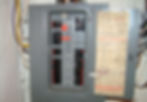How Dangerous is my Federal Pacific Breaker Panel?
- Erin Hudgins
- Jan 25, 2020
- 3 min read

What is a Circuit Breaker Panel?
Your home's circuit breaker panel is likely tucked away in the garage or basement and you may not give it much thought until you have to reset a tripped breaker. However, this piece of equipment is the central hub of your home's electrical system and is vital in protecting your family from electric shock and preventing electrical fires. It works hard to protect your home from dangerous electrical events including:
external power surges (caused by lightning strikes or transformer failure)
circuit overload (plugging too many devices into one circuit)
short circuits (a hairdryer falling into a sink, or a nail puncturing an energized cable)

A functioning breaker cuts off the power to a circuit by "tripping" when it detects a problem. If your circuit breakers fail to trip, the wires can get so hot that they start a fire. Panels are frequently located around combustible material such as exposed studs and joists, creating the potential for fires that quickly become out of control. Melted wire insulation can create an electrocution hazard, and arcing or explosions can even occur in severe cases.
Unfortunately, this breaker failure happens every year in homes equipped with Federal Pacific Electric (FPE) Stab-Lok panels, leading to fires, property damage, injury, and even death.
What Makes Federal Pacific Panels So Dangerous?
The Consumer Product Safety Commission (CPSC) began an investigation in the early 1980s and hired electrical experts to test FPE Stab-Lok breakers installed in homes from 1960 to 1985. Fifty-one percent of the tested breakers failed to trip.
Unfortunately the scale of the investigation was massive and the Commission ended its investigation in 1983, stating, “Based on the Commission’s limited budget, the known hazards the Commission has identified and must address... and the uncertainty of the results of such a costly investigation, the Commission has decided not to commit further resources to its investigation of FPE’s circuit breakers.” Despite the early results and the number of electricians and home inspectors who warn against this equipment, FPE Stab-Lok panels were never officially recalled.
One member of the original CPSC investigation team, Jesse Aronstein, continues to speak out about the dangers of FPE Stab-Lok panels. An electrical engineer with a doctorate in materials science, Aronstein co-wrote a peer-reviewed paper which estimated that FPE Stab-Lok panel failures result in as many as 2,800 fires, 13 deaths, and $40 million in property damage annually.
My FPE Panel has Worked So Far, is it Safe to Keep in My Home?

The problem with a Federal Pacific Stab-Lok panel is that it can function perfectly fine, until suddenly it doesn’t. It only takes one short circuit or over-current event to fail.
The CPSC recommends getting this type of panel inspected by a qualified electrician “to look for any signs of overheating or malfunction among the circuit breakers.” However, after testing over 4,000 breakers, Aronstein has determined that you can only identify a defective

Stab-Lok breaker by first removing it and then testing it. This process can be time-consuming and more expensive than simply installing a new, less risky panel, so in most cases, it makes more sense to replace your Federal Pacific panel.
A panel replacement can typically be done in one day or less, and is often required by inspectors when you eventually sell your home.
How Can I Tell if I Own a Federal Pacific Stab-Lok Panel?


Millions of homes were built with FPE Stab-Lok panels between 1950 and 1990. If your home was constructed during this time frame, then it may contain one of these panels.
Usually, “Federal Pacific” or “FPE” will be written on the box’s front cover. Inside the

box, look for a label that says “Stab-Lok” in between the rows of breakers. The breakers have a signature red strip that runs across the top of the switch, and unlike most panels, the breaker switches face outward when energized.
If you have more questions about your Federal Pacific Panel, or would like to schedule an appointment to have yours replaced, please give us a call at 540-552-5397
